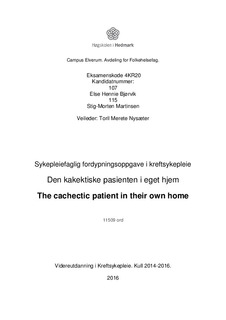| dc.contributor.author | Bjørvik, Else Hennie | |
| dc.contributor.author | Martinsen, Stig-Morten | |
| dc.date.accessioned | 2016-09-16T08:11:42Z | |
| dc.date.available | 2016-09-16T08:11:42Z | |
| dc.date.issued | 2016 | |
| dc.identifier.uri | http://hdl.handle.net/11250/2407720 | |
| dc.description | Fordypningsoppgave i kreftsykepleie, 2016 | nb_NO |
| dc.description.abstract | Bakgrunn: I perioden 2005-2014 var det i Norge 27416 nye tilfeller av cancer pulm, og kakeksi sees svært hyppig hos pasienter i palliativ fase, og forekommer ved 50-85% av langkommende avanserte kreftsykdommer. Opptil 20% av dødsfall hos kreftpasienter skyldes kakeksi.
Hensikt: Å tilegne oss økt kunnskap om ivaretagelsen av pasienter med kakeksi, og kunne nyttiggjøre denne kunnskapen i møte med kakektiske pasienter i palliativ fase.
Problemstilling: Hvordan kan kreftsykepleier i hjemmebasert omsorg bidra til å begrense utvikling av kakeksi, når en pasient i tidlig palliativ fase er hjemmeboende og utfordres med respirasjonsbesvær som følge av cancer pulm?
Metode: Oppgaven er bygd opp som en litteraturstudie og bygger i hovedsak på skriftlige kilder, som baseres på allerede eksisterende teori og forskning, i tillegg til vår erfaringsbaserte kunnskap.
Funn/diskusjon: Kakeksi er et multifaktorielt syndrom, og i tråd med den palliative kulturen, er det nødvendig med en helhetlig tilnærming.
Konklusjon: For at kreftsykepleier kan bidra til å begrense utviklingen av kakeksi i pasientens hjem, konkluderer vi med at kreftsykepleier bør ta utgangspunkt i pasientens situasjon, med en situasjonsbetinget tilnærming. | nb_NO |
| dc.description.abstract | Engelsk sammendrag (abstract): Background: During the period 2005-2014 there were in Norway 27416 new cases of lung cancer, and cachexia is seen very frequently in patients in palliative phase, and occurs 50-85% in cases with advanced cancer. Up to 20% of cancer patients die due to cachexia.
Purpose: To acquire more knowledge about the management of patients with cachexia, and how to utilize this knowledge towards a cachectic patient in palliative phase.
Problemstilling: How can an oncology nurse in home care help to limit the developement of cachexia, when a patient in early palliative phase is living at home and is challanged with respiratory distress caused by lung cancer?
Metode: The paper is designed as a literature study and are mainly based on written sources, witch are based on existing theory and research, in addition to our experience-based knowledge.
Funn/diskusjon: Cachexia is a multifactorial syndrome, and with the palliative culture, it requires a holistic approach.
Konklusjon: How the oncology nurse can assist to limit the developement of cachexia in the patient own home, we conclude that oncology nurse should base the patient`s situation, on a situational approach. | nb_NO |
| dc.language.iso | nob | nb_NO |
| dc.subject | kreftsykepleie | nb_NO |
| dc.subject | hjemmeboende | nob |
| dc.subject | living at home | eng |
| dc.subject.mesh | kreftsykepleier | |
| dc.subject.mesh | palliativ pleie | |
| dc.subject.mesh | kakeksi | |
| dc.subject.mesh | lungekreft | |
| dc.subject.mesh | lungesvulster | |
| dc.subject.mesh | oncology nursing | eng |
| dc.subject.mesh | palliative care | eng |
| dc.subject.mesh | cachexia | eng |
| dc.subject.mesh | lung cancer | eng |
| dc.subject.mesh | lung neoplasms | eng |
| dc.title | Den kakektiske pasienten i eget hjem | nb_NO |
| dc.title.alternative | The cachectic patient in their own home | nb_NO |
| dc.type | Student paper, others | nb_NO |
| dc.subject.nsi | VDP::Medical disciplines: 700::Health sciences: 800::Nursing science: 808 | nb_NO |
| dc.source.pagenumber | 61 s. | nb_NO |
